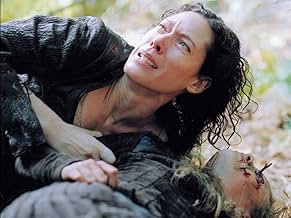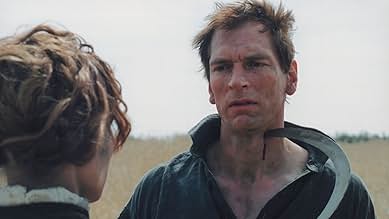Adicionar um enredo no seu idiomaAn uproar is caused when some mutilated cadavers are discovered, giving way to the legend of the "Werewolf of Allariz". A traveling vendor rolls through the forest in his old wagon. A woman ... Ler tudoAn uproar is caused when some mutilated cadavers are discovered, giving way to the legend of the "Werewolf of Allariz". A traveling vendor rolls through the forest in his old wagon. A woman from every village on his route faithfully awaits him. He's attractive, intelligent, charm... Ler tudoAn uproar is caused when some mutilated cadavers are discovered, giving way to the legend of the "Werewolf of Allariz". A traveling vendor rolls through the forest in his old wagon. A woman from every village on his route faithfully awaits him. He's attractive, intelligent, charming.... But he's also the monster feared by all. His most recent prey, Barbara will soon b... Ler tudo
- Direção
- Roteiristas
- Artistas
- Prêmios
- 1 vitória e 8 indicações no total
- Gómez
- (as Carlos Reig)
- Direção
- Roteiristas
- Elenco e equipe completos
- Produção, bilheteria e muito mais no IMDbPro
Avaliações em destaque
The film takes place in 1851, in a rural Spanish community where there has been a spate of deadly attacks, presumably by wolves. Travelling salesman Manuel Romasanta (played by the very English Julian Sands, who makes zero attempt at an accent) arrives in the area to visit his girlfriend Maru Valdivielso, who shares her home with her rather lovely sister Bárbara (Elsa Pataky) and their young deaf niece Teresa (Luna McGill).
Seemingly concerned for their safety, Manuel offers to escort Maria and Teresa to Santander, but the girls never make it to their destination, their charming travelling companion attacking them in the forest, believing himself to be a lycanthrope—a man who can transform into a wolf. When Manuel returns to Bárbara, he seduces the unsuspecting woman, but is unable to hide the truth for very long
With its mid-19th century European setting, ambiguous werewolf plot, and stunning visuals, Romasanta reminded me a lot of Christophe Gans' The Brotherhood of the Wolf; but like that film, Romasanta suffers from a plodding and slightly confusing narrative, one that makes matters hard going, even despite a few genuinely twisted moments involving sticks in eyes and the removal of body fat, a fairly decent transformation scene, and the sight of Pataky in a tin bath having her breasts soaped up by Sands.
But then you look closer. The wolf's mouth is larger than that of an ordinary dog, the teeth packed more densely together within. The wolf's eyes gleam a sickly yellow colour, and a vicious snarl augments the drool flowing from its mouth.
The creature leaps at you with supernatural speed and strength. Its front paws knock you flat on your back, and you feel the freezing earth soaking through your shirt, the full moon gleaming down like a cruel eye, watching you.
The wolf doesn't bother with a killing wound; it just begins to tear chunks of flesh from your stomach, ignoring your agonized screams. It will be a long, long time before your body loses all feeling, and everything goes dark.
Manuel Romasanta was a traveling merchant and salesman in the mid eighteen hundreds, who, at some point, went completely and utterly insane. He believed himself to be a werewolf, a man who would assume the form of an unnaturally large and brutal wolf whenever the moon was full. Manifesting from this belief was the need to kill, and so kill he did, some sixteen or more people, chosen completely at random, no discrimination. He would slaughter them, devour them and then leave the bodies for others to find.
There have been so many movies made that have been based on the lives of serial killers- Jack the Ripper, Jeffrey Dahmer, Ted Bundy, etc. It seemed a mere matter of time until they dredged up this psychopath from the history books and immortalized him through film.
But, of course, being set in the time that it is, and under the circumstances through which the events surrounding the case unfolded, they couldn't have been content merely to make a slasher/thriller sort of thing documenting the life of a serial killer. No, they had to turn it into a werewolf movie.
And what a fantastic werewolf movie it turned out to be. I was expecting the sorts of cheesy werewolf effects that we saw in such movies as "Dog Soldiers" and "Underworld" (although to tell you the truth, I enjoyed both of those movies, solely for the action content in them). But groundless were all my fears, for as the movie progresses it becomes increasingly clear that this is not your usual, run-of-the-mill type of werewolf crap, with Romasanta assuming the form of a proper wolf when he transforms. Rather than "Dog Soldiers", it portrays itself more as being along the lines of "Ginger Snaps", with much the same sort of tragic tale at the heart of it.
As with seemingly all new-age horror movies, even those done in an older sort of style (such as this one), there is a love story at the heart of the movie. However, true to the bizarre nature of this movie, it is not a happy tale of love that unfolds, rather a twisted tragedy in which neither side comes off any better than the other. For those of you who possess something like a twisted romanticism, I tell you now not to miss this one, you'll regret it if you do.
I've already told you basically all you need to know about the story of this movie, and I'm not going to ruin all the twists and turns of the movie so as to spoil your viewing enjoyment. Just be sure not to miss this one, especially if you liked "Ginger Snaps".
However, scientifically, and/or historically literate viewers will find one nagging, glaring blunder; at one point in this story, which is supposed to be set in the mid 19th century, there is a reference to a person being controlled "by his genes". Come on! The term "gene" wasn't even proposed until half a century later, and additionally, around mid 19th century the mechanism of inheritance was entirely unknown; Mendel's work lay undiscovered until early 20th century, and even Mendel didn't use the word "gene" (so it couldn't have been a case of some exceptionally insightful scientist having discovered the term in some ).
That sort of a slip may not seem much, but for someone aware of this history, it does brake the illusion of an authentic world in which the events are set, making it harder to enjoy the movie. I'm surprised that anybody reviewing the script didn't pick up on it... but then again, the state of scientific literacy among filmmakers is often abysmal. In a movie set in a historical period, accuracy should be more of a priority though, I think.
The story proceeds almost languidly, punctuated by moments of violence and terror; perhaps too slow for most horror fans to appreciate, and those who do appreciate the subtlety are likely to be bothered by the "gene" mishap. The score is beautiful, and lighting is used to good effect; the combination makes for a visually and auditorily pleasing experience.
Perhaps because of how the movie is portrayed as a werewolf movie, the people who might best enjoy it, aren't likely to see it, and the people expecting a traditional supernatural horror movie might feel a bit let down.
In conclusion, Romasanta is a movie not as good as it could have been, and somewhat misleadingly advertised on the cover, but well worth seeing nonetheless. I was torn between 7 or 8 stars, and decided to be generous. :)
The story of Manuel Blanco Romasanta is quite a well known one in Spain. It happened in the mid-nineteenth century, when a string of violent deaths took place which seemed in some ways like animal attacks, and in others like cold and calculated murder. Eventually a man was arrested -- Manuel Romasanta, and it was found that he used the body fat from his victims to make soap. At his trial he claimed that he became a werewolf, and that it is the nature of a wolf to kill. He was diagnosed with the psychological condition of lycanthropy, and given a life sentence rather than death.
The film itself is based largely on truth, partly on speculation and partly on pure invention for artistic purposes. It's certainly a lot closer to the truth than "Brotherhood of the Wolf" was, anyway. One character is knowingly invented, and some rather unlikely theories are put forward in the place of that which is unknown, but the question of whether or not Romasanta was actually a werewolf is left completely open. Paco Plaza appears to be a competent and innovative director, and the style of the film is really superb. It is quite slow moving, and arguably it's rather light on actual story and plot, but that's about as far as the criticism goes.
There are several great performances, but the standout comes from Julian Sands as the title character, who submerges himself in the role in the way that only outstanding actors can. John Sharian is also very good as the misguided, haunted 'partner' of Romasanta, and both Gary Piquer and David Gant are memorable in supporting roles as those who finally bring the murderer to justice. It also features Elsa Pataky as the leading heroine, who has become a huge sex symbol in Spain and it isn't hard to see why -- think along the lines of a Spanish Keira Knightley.
This is the finest historical werewolf film I've ever seen, and any self-respecting werewolf buff should take a look, but unfortunately there's not much chance of this one being a blockbuster.
Você sabia?
- CuriosidadesBased on the case of serial killer Manuel Blanco Romasanta who murdered at least 13 people in 1850s Spain. He claimed a curse turned him into a wolf causing him to kill. Because of these claims, Queen Isabella II acquitted him, but he died in jail before being released. The Romasanta case previously inspired Carlos Martínez-Barbeito's novel "El bosque de ancines", filmed as El bosque del lobo (1970).
- Erros de gravaçãoWhen Barbara first holds the sickle to Romasanta's neck, a black safety cap is visible on the tip.
- Cenas durante ou pós-créditosThe opening Filmax logo, usually a white sphere with three stripes (yellow, red and blue), turns into a full moon.
- ConexõesEdited into Así se hizo 'Romasanta, la caza de la bestia' (2004)
Principais escolhas
- How long is Romasanta: The Werewolf Hunt?Fornecido pela Alexa
Detalhes
Bilheteria
- Orçamento
- € 4.500.000 (estimativa)
- Faturamento bruto mundial
- US$ 813.586
- Tempo de duração1 hora 30 minutos
- Cor
- Mixagem de som
- Proporção
- 2.35 : 1
Contribua para esta página































